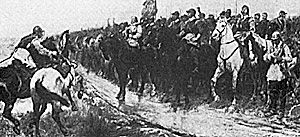 Farmington Moor is perhaps noteworthy as being the
first 15mm ECW battle to be recorded in a battle report by
the Southern Maine Wargamers Association. First of a four
battle series campaign, Farmington Moor used home-grown
rules flagrantly stealing from both CAVALIERS AND
ROUNDHEADS by Perren & Gygax, and also
WARGAMER'S GUIDE TO THE ENGLISH CIVIL WAR by
Bill Protz, Jr., with great emphasis being placed by us on
simplicity, ease of movement, speedy combat resolution,
and instantaneous death to all those persons foolish enough
to argue with the referee.
Farmington Moor is perhaps noteworthy as being the
first 15mm ECW battle to be recorded in a battle report by
the Southern Maine Wargamers Association. First of a four
battle series campaign, Farmington Moor used home-grown
rules flagrantly stealing from both CAVALIERS AND
ROUNDHEADS by Perren & Gygax, and also
WARGAMER'S GUIDE TO THE ENGLISH CIVIL WAR by
Bill Protz, Jr., with great emphasis being placed by us on
simplicity, ease of movement, speedy combat resolution,
and instantaneous death to all those persons foolish enough
to argue with the referee.
Although the dates, area, roads etc. are all imagination, as is the title of the battle, the names of the units, and combat bonuses attributed, are based upon what meager readings we have been able to find about the era. 10-20% of the unit names are fiction, some are puns (Cpt. Lawrence Kriete's Battery) or what-have-you. The troops are 15mm MiniFigs, generally based upon the Protz rules, using 1:20 for horse and foot; 1:2 for cannon.
Situation
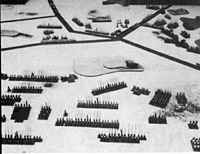 The Parliamentarian Army has, unfortunately for the
King, just out-maneuvered his Army of the North. The
Association is seeking some sort of reasonable sized
encounter with His Majesty, and has placed itself between
him and York, thereby causing a situation which the King
must attempt to correct at once. The Roundhead Army has
arrived on the night before the battle, as part of the Royalist
Army watches cautiously.
The Parliamentarian Army has, unfortunately for the
King, just out-maneuvered his Army of the North. The
Association is seeking some sort of reasonable sized
encounter with His Majesty, and has placed itself between
him and York, thereby causing a situation which the King
must attempt to correct at once. The Roundhead Army has
arrived on the night before the battle, as part of the Royalist
Army watches cautiously.
At dawn the Roundheads are more or less in position to give battle, while the Marquis of Newcastle anxiously watches the York Road in a southerly direction, and wonders to himself, where in God's name are Rupert and the King? At 10AM, just as the Parliamentarian cannon begin to bombard the Royalist position, Rupert and the entire Right Wing of the Royalists come into view, and the battle is joined. Inexplicably, the King is nowhere in sight...
THE PROTAGONISTS
| Parlamentarian | Royalist |
|---|---|
| John Reid . . . Sir William Waller & Col. Oliver Cromwell | Larry Kriete . . . Lord Byron & Prince Maurice |
| Gordon Stone . . . The Earl of Essex & Lt. Gen. Baillie (Scot) | Ray Brulotte . . . Marquis of Newcastle & King Charles I |
| Paul Marchol . . . Maj. Gen. David Leslie | Mark D'Anci . . . Prince Rupert |
| Burt Labelle . . . gamesmaster, creator of scenario, arbitrator. | |
THE KING'S ARMY OF THE NORTH
(ED NOTE: Parenthetical +,- numbers are fire & melee bonus/penalty.)
THE LEFT: Lord Byron (also: Prince Maurice)
-
(1) Clan Gordon H ighlanders (Scot) 480 Heavy Foot ( + 1 )
(2) Cpt. Richard Graham's Battery Saker (5#)
(3) Cpt. Robert Hughes' Battery Saker (5#)
(4) Col. Blackwall's Regt.540 Musket & Pike
(5) Col. Sir Edward Stradling's Regt. 540 Musket & Pike
(6) Staffs County Militia 300 Musket ( - 1 )
(7) Col. Henry Washington's Dragoons 120 Dragoons
(8) Queen's Lifeguard Regt. 600 Musket & Pike (+1)
(9) King's Lifeguard Regt. 600 Musket & Pike (+2)
(10) Col. Thomas Lunsford's Regt. 600 Musket & Pike
Prince Maurice's Brigade
- (11) Prince Maurice's Lifeguard Regt. 120 Horse (+1)
(12) King's Lifeguard Regt.180 Horse (+1)
(13) Sir Edward Widdrington's Regt. 300 Horse
(14) Prince Maurice's Regt 180 Horse
(15) Com.-Cen. Ceorge Porter's Troop 60 Horse
THE CENTER: Marquis of Newcastle
(Note: upon his arrival, the King assumes direct control over the center forces.)
-
(16) Cpt. John Butler's Battery Saker (7#)
(17) Earl of Newcastle's Regt. 600 Musket & Pike (+2)
(18) King's Foot Bodyguard 80 Musket
(19) Col. Th Blagg's Militia Regt. 320 Militia ( - 1)
(20) Col. Talbot's Regt 540 Musket & Pike
(21) King's KilligrewServants 120 Horse(+1)
(22) Centlemen Pensioners60 Horse ( + 1)
(23) Col. Richard Bolles' Regt.480 Musket & Pike
(24) Cpt. Robert Foster's Battery Saker (5#)
(25) Cpt. Thomas Edwards' Battery Culverin (15#)
(26) Cpt. Roger Ince's BatteryMinion (3 1/2#)
(27) Col. Fenwick -- The Forlorn Hope 300 Musket
(28) Lord Hopton's Regt.600 Musket & Pike
(29) Col. John Okey's Dragoons80 Dragoons
THE RIGHT: Prince Rupert's Brigade
- (30) Prince Rupert's Lifeguard Regt. 120 Horse ( + 2)
(31) Prince Rupert's Regt.300 Horse ( + 2)
(32) Cpt. William Stoakes' Battery Falcon (2 1/2#)
(33) Sir John Byron's Regt. 300 Horse
(34) Earl of Carnavon's Regt.240 Horse
(35) Col. Thomas Aston's Regt. 120 Horse
(36) Lord Wilmot's Regt. 300 Heavy Horse
(37) Cpt. Thomas Fitch's Battery Falcon (2 1/2#)
(38) Col. Sir Edward Duncombe's Drag. 200 Dragoons
TURN 3 REINFORCEMENTS: King Charles I
-
(38) Col. Samuel Tuke's Regt. 240 Horse
(39) Col. Thomas Leveson's Regt. 240 Horse
(40) Col. Edward Grey's Dragoons 80 Dragoons
(41) Cpt. Anthony Meynell's Battery Falconet (2#)
(42) Marquis of Newcastle's Regt. 240 Horse
THE ASSOCIATION'S NORTHERN ARMY
THE RIGHT: Sir William Waller (Also: Col. Oliver Cromwell)
-
(A) Col. George Thompson's Regt. 300 Heavy Horse
(B) Col. Edward Cooke's Regt. 120 Horse & Lance
(C) Lord Brooke's Regt. 120 Horse & Lance
(D) Col. Oliver Cromwell's Regt. 360 Horse ( + 2)
(E) Col. Sir William Waller's Regt. 240 Horse
(F) Col. William Norton's Regt. 60 Horse
(G) Col. Jonas Vandruske's Regt. 240 Horse
(H) Maj. Alex Douglas' Troop 60 Heavy Horse
(I) Cpt. Lawrence Kriete's Battery Culverin (15#)
( J ) Col. Sir Henry Cholmley's Regt. 540 Musket & Pike
(K) Westminster Auxiliaries 240 Militia ( - 1)
(L) Cpt. J spin. Skrimpshiere Battery Saker (5#)
(M) Cpt. Edward Gray's Battery Minion (3 1/2#)
THE CENTER: The Earl of Essex (Also: Lt. Gen. Baillie [Scot])
-
(N) The Earl of Essex's Regt. 840 Musket & Pike ( + 1)
(O) Sir J ohn Meldrum's Regt. 840 Musket & Pike
(P) Sir John Merrick's Regt. 600 Musket & Pike
(Q) Col. Thomas Ballard's Regt. 540 Musket & Pike
(R) The Tower Hamlets 320 Militia ( - 1) (S) Col. John Hampden's Regt. 660 Musket & Pike ( + 1 )
(T) Cpt. Bevell Prideaux's Battery Saker (5#)
(U) Cpt.-Lt. Ceorge Rowse's Battery Saker (5#)
(V) Cpt. Bussy Basset's Battery Falcon (2 1/2#)
(W) Col. John Browne's Dragoons 200 Dragoons
(X) Lt. Col. George Dundas' Dragoons 80 Dragoons
(Y) Earl of Eglington's Regt. (Scot) The Ayershire Lancers 300 Lance ( + 1)
(Z) Gen. Sir Alexander Hamilton's Regt. ( Scot) 460 Musket & Pike ( + 1 )
(AA) Lord Robartes' Regt. 840 Musket & Pike
(BB) Cpt. John Lloyd's Battery Saker (5#)
(CC) Cpt. John Byrd's Battery Minion (3 1/2#)
THE LEFT Maj. Gen. David Leslie
-
(DD) Lord Mandville's Regt. 660 Musket & Pike
(EE) Earl of Stamford's Regt. 540 Musket & Pike
(FF) Col. Sir William Balfour's Regt. 240 Horse
(GG) Col. Sir Michael Livesy's Regt. 180 Horse & Lance
(HH) Cpt. Henry Ireton's Troop 60 Horse
(II) Southwark Auxiliaries 320 Militia ( - 1)
(JJ) Earl of Essex's Regt. 300 Heavy Horse (+1)
(KK) Lord of St. John's Regt. 120 Horse
(LL) Cpt. Thomas Tyrell's Troop60 Horse
(MM) Cpt. Joseph Brand's Battery Falcon (2 1/2#)
(NN) Cpt. James Temple's Battery Falcon (2 1/2#)
(00) Cpt. George Walsh's Battery Falcon (2 1/2#)
(PP) Col. James Wardlawe's Dragoons 200 Dragoons
(00) Col. John Neale's Regt. 120 Horse
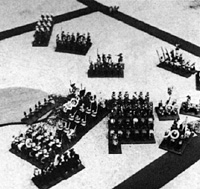 Royalist -- You are outnumbered considerably in cannon
and foot, even in numbers of horse, although your horse is of superb
quality, the enemy has heavy units in abundance for such a medium-
sized engagement. Under normal circumstances, to attack would be
foolish. You are required, therefore, to hold your ground at all costs
and to inflict losses upon the Roundhead Army at the highest rate
possible until such time as it will be required to withdraw.
Royalist -- You are outnumbered considerably in cannon
and foot, even in numbers of horse, although your horse is of superb
quality, the enemy has heavy units in abundance for such a medium-
sized engagement. Under normal circumstances, to attack would be
foolish. You are required, therefore, to hold your ground at all costs
and to inflict losses upon the Roundhead Army at the highest rate
possible until such time as it will be required to withdraw.
Parliamentarian -- You have placed yourself between the King and York. The King's Army is flustered at having been outmaneuvered, and at the moment a bit disorganized -- but in high spirits. You appear to have an advantage in numbers in all arms, and therefore are ordered to make a general attack up and down the line on the. entire Royalist position, in an attempt to sweep the entire Army before you. At the very least, due to your superior numbers, you must cause the Royalist Army to involuntarily withdraw before you. (Note: we use an army CE rule, that is, when an Army reaches 50% CE, it must withdraw, and the victorious side is given a slight Tactical Victory, after all factors are accounted for. )
THE BATTLE
Battle diaries were kept by Sir William Waller, Maj. Gen. David Leslie, Lord Byron, and Prince Rupert. While some of these diaries were more helpful than others, they will all be quoted and noted from time to time. All statements not attributed to these diaries are by the gamesmaster.
Turns 1-3: General advance by entire Parliamentarian Army towards Royalist. Forlorn Hope (Col. Fenwick commanding) destroyed by consecutive turns of massed Parliamentarian battery fire. Earl of Newcastle's Regt. takes casualties from effective long range fire. Rupert advances entire wing towards Pembroke's Rump and the near ford. Minimal casualties on both sides due to range.
Lord Byron: "As the closest to the crossroads and facing a typical Roundhead infantry regiment (equal to two Royalist infantry regiments) I theorized that to advance would have exposed flanks to attack from Cromwell's and Thompson's Horse Regiments, therefore, it is best for me to await his attack."
1. GM NOTE: Granted a large Parliamentarian Regt., such as The Earl of Essex's with 840 foot is nearly twice as large as Col. Blackwall's Regt. with 540 foot, this is a bit of an overstatement, and the average regiments on both sides are closer by comparison, with Roundhead regiments generally larger.
Sir William Waller: "A look at the terrain on the Parliamentarian right will show an area suitable for a holding or defensive battle only. At first glance I thought the Royalist left would be used to reinforce the center so that their right could be better covered. My first move was to try to overwhelm the Royalists by my advantage in numbers, but this was not to be. The Royalists moved up into a strong line with considerable reserves. Two units of elite infantry and four other foot regiments with cavalry support. Too much for me to attack frontally. "
Turns 4-6: Both armies are closing range, and various regiments on both sides are withered by musket fire to the point of destruction or routing off. Lord Robartes routed off. Earl of Newcastle (an elite unit) was destroyed. Earl of Essex's lobsters routed off. Sir John Merrick's decimated. Then, on turn 6, the beginning of a massive cavalry engagement on the Royalist right flank, involving, of course, Prince Rupert. Lord Byron: "By turn 4 I have found artillery to be more effective than anticipated -- and have lost effective use of my two batteries." Sir William Waller: "My counter-battery fire has cleared his artillery and allowed me to hammer his infantry. I at first marched my reserve infantry regt. towards our center, and then changed my mind and counter-marched it back to our right -- just as our center faltered. My considerable cavalry strength made my opponent (Lord Byron) apprehensive and he formed his regiments into rings. I love it."
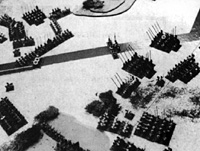 Turns 7-9: The massive horse battle develops and is
resolved. Rupert's and Rupert's Lifeguard Regiments are
charged by The Ayershire Lancers, Col. Sir William
Balfour's Regt., and Lord St. John's Regt. Casualties
horrendous on both sides. On the following turn, Col.
Samuel Tuke's and The King's Lifeguard charged home for
the Royalists, and seven horse regiments were engaged in
a wild melee. Result: Rupert's, Rupert's Lifeguard, Balfour's,
The Ayershire Lancers, and Lord St. John's all routed off or
destroyed after three turns of savage fighting. The
preponderance of horse on the Royalist right was beginning
to show, while the large group of Roundhead horse in
Waller's group was accomplishing little other than
assuming a threatening posture. Also, during this period,
the King arrives and brings with him a) several regts. of
horse b) a great deal of tactical experience and c) a morale
boost with his personality, also causing a few groans on the
Roundhead side. The Bender of Rules and Roller of Hot
Dice has arrived! Lord Byron: "Nerves getting bad, tried to
lure out Cromwell's Cavalry out by sacking some horse
(Maurice's Lifeguard -- admitted poor choice) in a charge
against Sir John Meldrum's intact Regt. Didn't work." Sir
William Waller: "The change in command on the Royalist
side was quite apparent as their strategy & tactics were
considerably improved during our second session."
Turns 7-9: The massive horse battle develops and is
resolved. Rupert's and Rupert's Lifeguard Regiments are
charged by The Ayershire Lancers, Col. Sir William
Balfour's Regt., and Lord St. John's Regt. Casualties
horrendous on both sides. On the following turn, Col.
Samuel Tuke's and The King's Lifeguard charged home for
the Royalists, and seven horse regiments were engaged in
a wild melee. Result: Rupert's, Rupert's Lifeguard, Balfour's,
The Ayershire Lancers, and Lord St. John's all routed off or
destroyed after three turns of savage fighting. The
preponderance of horse on the Royalist right was beginning
to show, while the large group of Roundhead horse in
Waller's group was accomplishing little other than
assuming a threatening posture. Also, during this period,
the King arrives and brings with him a) several regts. of
horse b) a great deal of tactical experience and c) a morale
boost with his personality, also causing a few groans on the
Roundhead side. The Bender of Rules and Roller of Hot
Dice has arrived! Lord Byron: "Nerves getting bad, tried to
lure out Cromwell's Cavalry out by sacking some horse
(Maurice's Lifeguard -- admitted poor choice) in a charge
against Sir John Meldrum's intact Regt. Didn't work." Sir
William Waller: "The change in command on the Royalist
side was quite apparent as their strategy & tactics were
considerably improved during our second session."
Turns 10-12: The entire battle reaches a highwater mark, with decisive actions taking place on left, center, and right. On the Royalist right, remnants of Rupert's Brigade (now consisting of parts of three regiments) charge and wipe out Pridueax's and Rowse's batteries. In the center, with an ill-advised move, Sir William Waller counter-orders Hamilton's Scots and Col. John Hampden's Regiment to make a direct over-the-top assault on the Redoubt. Hamilton and Hampden die in a blaze of glory and stupidity. On the Royalist left, Widdrington's Regt. of Horse charges and sabres Skrimpshire's and Gray's batteries, thereby causing the loss in one turn of almost half the entire Roundhead cannon! Widdrington pays the price, and is decimated in turn. It is all for naught, however, as the Royalist Army, after a slow start combined with an outstanding recovery in the later turns, reaches 50% CE. The King, reluctantly, gives the order to withdraw. The Association's Northern Army has carried the day, primarily die to superior numbers. Statistic freaks take note: in the last two turns of the battle (10 & 11) the Royalist/Roundhead casualty ratio was just under 3 to 1. The gamesmaster declares The Battle of Farmington Moor a Marginal Parliamentarian victory. The sides take leave, each swearing to do better in the next engagement, to right the wrongs of this one.
AWARDS/DEMOTIONS
Parliamentarian -- Earl of Essex: No action taken. Lt. Gen. Baillie: returned to Edinburgh, has sworn never to fight for Parliament again after suicidal attack on the Redoubt. Col. Oliver Cromwell: censured for lack of initiative. Maj.Gen. David Leslie: lukewarm commendation from the Eastern Association in view of the fact he was only Parliamentarian leader not to commit a rather large blunder on the day of battle. Sir William Waller: Forced into two month retirement, reprimanded. Ordered Scot attack on the Redoubt, and failed to use initiative on the Right flank.
Royalist -- King Charles I: In consideration for promotion to God after almost saving the whole bloody mess. Marquis of Newcastle: Praised. Prince Rupert: Commendation for excellent handling of Horse. Sent to Military Academy, Broadhurst, for two weeks intensive training on how to correctly handle and employ dragoons. Prince Maurice: Commended for timely destruction of Roundhead batteries in later stages of battle. Lord Byron: Cashiered. Banished by the King until further notice. Ordered attack of Maurice's Lifeguard vs. intact Roundhead foot regiment. Thought Blackwall's Regiment was the King's Lifeguard, allowing the real King's Lifeguard to be shot through with cannon-fire for three consecutive turns before realizing error.
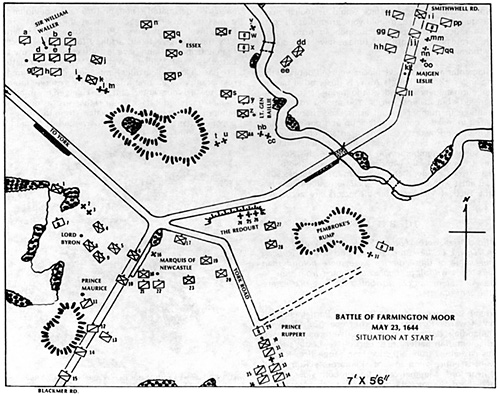
Back to Table of Contents -- Courier Vol. 2 #5
To Courier List of Issues
To MagWeb Master Magazine List
© Copyright 1981 by The Courier Publishing Company.
This article appears in MagWeb (Magazine Web) on the Internet World Wide Web.
Other military history articles and gaming articles are available at http://www.magweb.com